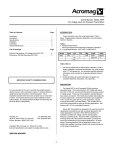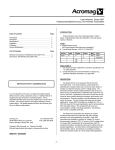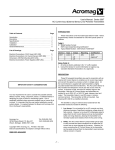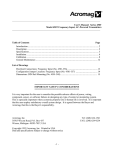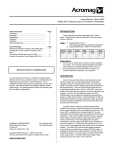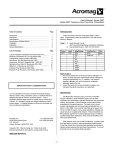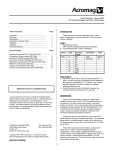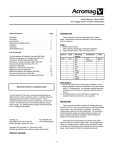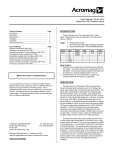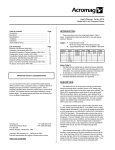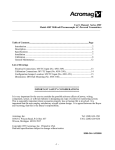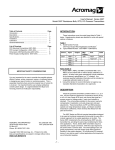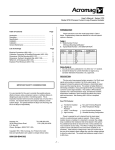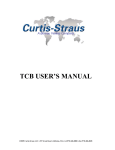Download - 1 - User`s Manual: Series 450T AC Current Input
Transcript
User's Manual: Series 450T AC Current Input (External Sensor), AC-Powered Transmitters INTRODUCTION: Table of Contents Page Introduction Description Specifications Installation Calibration General Maintenance These instructions cover the model types listed in Table 1 below. Supplementary sheets are attached for units with special options or features. 1 1 2 3 4 5 List of Drawings Table 1: A. Model Number Format : 450T-Input-Output-Power-Mounting-Certification1 B. Typical Model Number: 450T-CACX-Y-1-DIN-NCR1 Page Electrical Connections: CACX Input (4501-379) Electrical Connections: AC Current Sensor (4501-380) Dimensions: DIN Rail Mounting (4501-348) Series 450T 6 7 8 -Input -CACX -Output -Y -V0 -V5 -Pwr. -1 -2 -Mtg. -DIN -Cert. -NCR -Approval2 Notes (Table 1): 1. All units are factory calibrated (No “-C” suffix needed). 2. Consult the factory for current information on agency (e.g. Canadian Standards Association, etc.) approvals. DESCRIPTION: These AC-powered transmitters are used in conjunction with an external AC Current Sensor to condition an AC current input signal and convert this signal to a process current or voltage output. An AC Current Sensor is supplied with each transmitter (a highly accurate toroidal instrument transformer). The AC Current Sensor is fully insulated and designed to mount near the source of the AC current. It transmits a safe, low-level DC milliamp signal to the transmitter. Both the AC Current Sensor and transmitter are isolated for up to 250V AC, or 345V DC peak, between input and output. The transmitter also includes power circuit isolation. Series 450T transmitters are available for 115V, or 230V AC power (for DC power applications, see the Acromag Series 350T). The versatile DIN rail mount of this device can accommodate a variety of mounting applications. See Drawing 4501-379 for a simplified schematic. IMPORTANT SAFETY CONSIDERATIONS It is very important for the user to consider the possible adverse effects of power, wiring, component, sensor, or software failures in designing any type of control or monitoring system. This is especially important where economic property loss or human life is involved. It is important that the user employ satisfactory overall system design. It is agreed between the Buyer and Acromag, that this is the Buyer's responsibility. Acromag, Inc. 30765 Wixom Road, P.O. Box 437 Wixom, Michigan 48393-7037, USA The benefits to using an external sensor (external from the transmitter enclosure) include the following: 1. Low losses: It is not practical to run AC currents over long distances because of significant resistance voltage drops at high currents. However, a low level DC milliampere signal is output from the AC Current Sensor and can be transmitted safely over long distances, allowing the transmitter to be remotely located some distance from the AC power wiring. Tel: (248) 624-1541 FAX: (248) 624-9234 2. Safety: The AC Current Sensor's output leads can be open or short circuited and these conditions do not affect the AC current loop or cause damage to the sensor. Likewise, the wires connecting the AC Current Sensor to the transmitter can be easily removed from the transmitter's input terminals without concern or hazard. Copyright 1994, Acromag, Inc., Printed in the USA. Data and specifications are subject to change without notice. 8500-504-A94A000 -1- Series 450T User's Manual AC Current Input (External Sensor) ___________________________________________________________________________________________ 3. Ease of Calibration: The AC current input range can be easily scaled in the field by simply changing the number of primary turns at the sensor, with no additional calibration required. The transmitter is factory calibrated and can be used with any AC Current Sensor (Acromag Model 5020-350). The AC current input span is a simple function of the number of primary turns placed on the AC Current Sensor and transmitter calibration is not affected. Refer to Applications "A" and "B" of Drawing 4501-380. This method of changing ranges is much easier, more accurate, and convenient. SENSOR PRIMARY TURNS 4 AC CURRENT INPUT RANGE 0 to 5 Amps AC TRANSMITTER OUTPUT (450T) 4-20mA or VDC 1 2 10 20 0 to 20 Amps AC 0 to 10 Amps AC 0 to 2 Amps AC 0 to 1 Amps AC 4-20mA or VDC 4-20mA or VDC 4-20mA or VDC 4-20mA or VDC MODEL/SERIES: 450T- (Color coded with a white label) INPUT (Sensor and Transmitter): AC Current Sensor (5020-350): One sensor is supplied with each Model 450T-CACX transmitter. The sensor is a highly accurate toroidal instrument transformer used to convert an AC current signal to a low level DC milliampere signal (0 to 11.17mA). The input AC current range is a simple function of the number of turns placed on the AC Current Sensor (see table below). The user configures the current sensor with the required number of primary turns to obtain the desired input span. AC CURRENT INPUT RANGE 0 to 5 Amps AC PRIMARY TURNS 4 0 to 20 Amps AC 0 to 10 Amps AC 0 to 2 Amps AC 0 to 1 Amps AC The Series 450T is another member of the Acromag flat-pack, DIN-rail mounted instrument family. It provides another functional component for a modular solution to varied field applications. Other Series 450T transmitters are available to condition voltage, current, frequency, RTD, thermocouple, slidewire/potentiometer, and AC voltage input signals. The Series 450T complements the Acromag Series 350T DC-powered transmitters, providing the same input conditioning for AC-powered applications. The modular approach of this design and companion Acromag flat-pack modules allows additional transmitters, input modules, isolators, and alarms to be easily integrated, as required. 1 2 10 20 SENSOR OUTPUT (RED/BLACK WIRES) 0 to 11.17mA DC 0 to 11.17mA DC 0 to 11.17mA Dc 0 to 11.17mA DC 0 to 11.17mA DC The output wires on the sensor are polarized: the Red wire is (+) plus and Black wire is (-) minus. Normally, these output wires are attached to one end of a cable (user supplied), and the other end connects to the transmitter's plus(+) and minus (-) input terminals. Input Burden: A function of the wire gauge resistance used for the primary turns. Input Overload: The AC Current Sensor withstands overloads as follows: The 450T transmitter is EMI and RFI protected, operates over a wide temperature range, and features excellent temperature coefficients which minimize the effects from harsh plant environments. In addition, the safe, compact, rugged, and reliable design of this transmitter allow it to be used in control room or field locations. • • • 20 times full-scale for 0.01 second 10 times full-scale for 0.1 second 5 times full-scale for 1.0 second AC Current Sensor to Transmitter Wiring Distance: 400 feet maximum for 18 AWG wire gauge. Other wire gauges can be used as long as the resistance of both wires is less than 5.0 ohms. Input wiring is inserted in the bottom of the unit, while output and power wiring is inserted at the top of the unit. Screws to secure the wiring are located on the front panel. Connectors are screw-clamp type and accept wire size up to 14 AWG. Transmitter (250T-CACX): -CACX: The Input to the transmitter is 0 to 11.17mA DC (output from the AC Current Sensor). This signal represents 0 to 5 Amps AC at the input to the AC Current Sensor with 4 primary turns, or any other AC current range. AC current range is a simple function of the number of primary turns. Changing the number of primary turns does not change the calibration of the transmitter. SPECIFICATIONS: Function: This family of isolated, AC-powered, sensor/transmitter pairs condition an AC current input and convert this signal to a process current or voltage output. The sensor is designed to be field mounted near the AC current it is measuring and transmits a low level DC milliamp signal to the transmitter’s input. The sensor and transmitter are both isolated between input and output. The transmitter also includes power isolation. The transmitter zero and span adjustments utilize 22-turn potentiometers accessible from the front of the unit. Optional 115V or 230V AC power is available. This transmitter is DIN-rail mounted. Isolation (Both Sensor and Transmitter): The input circuit is electrically isolated from the output circuit (transmitter and sensor), and the power circuit (transmitter), allowing the input to operate at up to 250V AC, or 354V DC off ground, on a continuous basis (will withstand 1500V AC dielectric strength test for one minute without breakdown). This complies with test requirements outlined in ANSI/ISA-S82.01-1988 for the voltage rating specified. -2- Series 450T User's Manual AC Current Input (External Sensor) ___________________________________________________________________________________________ EMI Resistance: Less than ± 0.25% of output span effect with switching solenoids or commutator motors. OUTPUT: Process Current or Voltage output. Voltage outputs are designed to provide true voltage output, with zero volts included, and to be stable with capacitive loads. Surge Withstand Capability (SWC): Input/Output terminations are rated per ANSI/IEEE C37.90-1978. Unit is tested to a standardized test waveform that is representative of surges (high frequency transient electrical interference), observed in actual installations. - Y: 4 to 20mA DC, R-Load = 0 to 600 ohms -V0: 0 to 10V DC into 10,000 ohms or greater -V5: 0 to 5V DC into 5,000 ohms or greater NOTE: For process current output (-Y units), the loop current may be monitored by placing a DVM between the Output (S) and Output (+) terminal. This connection measures the current drop through a precision 10 ohm resistor placed in series with the Output (+) terminal (± 0.1%, ± 25ppm). A DVM measurement of 40mV corresponds to 4mA, and 200mV corresponds to 20mA of loop current. For voltage outputs (-Vx units), the Output (S) terminal is electrically equivalent to the Output (+) terminal. Construction: AC Current Sensor: Epoxy dipped and baked. Circuit Boards: Military grade FR-4 epoxy glass circuit board. Circuit Board Coating: Fungus resistant acrylic conformal coat. Terminals: Compression type, wire size 14 AWG maximum. Mounting Position: Position insensitive. Case: Self-extinguishing NYLON Type 6.6 polyamide thermoplastic UL94 V-2, color black. General Purpose, NEMA Type 1 enclosure. Output Limiting: Voltage units (-Vx): 120% of full scale output, nominal. Current unit (-Y): 125% of full-scale output (24mA), nominal. MOUNTING: -DIN: General Purpose Housing, DIN-Rail Mount - "G" & "T" rails. "G" Rail (32mm), Type EN50035; "T" Rail (35mm), Type EN50022. Refer to Drawing 4501-348 for outline and clearance dimensions. Shipping Weight: 1 pound (0.45 Kg) packed. Output Ripple: Less than ±0.1% of the maximum output span. POWER: -1: 115V AC ±10%, 50 to 60Hz, 0.05A (-Y units), 0.020A (-Vx units). -2: 230V AC ±10%, 50 to 60Hz, 0.025A (-Y units), 0.010A (-Vx units). CERTIFICATION: Consult the factory for current information on the availability of agency (e.g. Canadian Standards Association, Factory Mutual, etc.) approvals. Power Supply Effect: Less than ±0.01% of output span for rated supply variations. -NCR: No Certification Required. Reference Test Conditions: Input: 0 to 5 Amps AC, 60Hz. (4 turn primary); Output (-Y units): 4-20mA DC (500 ohm load); Output (-Vx units): 0-10V DC into 10K ohms or greater; Ambient 77oF (25oC); 115V AC supply. INSTALLATION: The transmitter is packaged in a general purpose enclosure. Use an auxiliary enclosure to protect against unfavorable environments and locations. Maximum operating ambient temperatures should be within -13oF to 185oF (-25oC to 85oC) for satisfactory performance. Factory calibrated units are ready for installation. Connect the unit as shown in Connection Drawing 4501-379. If the unit is not factory calibrated, refer to the "CALIBRATION" section. Accuracy: Better than ±0.5% of calibrated span. This error includes the combined effects of transmitter repeatability, hysteresis, terminal point linearity, adjustment resolution, and AC Sensor error. Ambient Temperature Range: -13oF to 185oF (-25oC to 85oC). Ambient Temperature Effect: Less than ±0.01% of output span per oF (±0.018% per oC) over the ambient temperature range for reference test conditions. Specification includes the combined effects of zero and span over temperature. Mounting: Mount transmitter assembly - refer to Drawing 4501-348 for mounting and clearance dimensions. DIN Rail Mounting: Use suitable fastening hardware to secure the DIN rail to the designated mounting surface. A transmitter can be mounted to either the "T" or "G" Rail. Installation of the transmitter to the rail depends on the type of DIN rail used (see Drawing 4501-348). Units can be mounted side-by-side on 1.6 inch centers, if required. Bandwidth: -3dB at 2Hz, typical (transmitter only). Response Time: For a step input, the output reaches 98% of its transition in 300ms, typical (transmitter only). Noise Rejection: Common Mode: Better than 130dB at 60 Hz, typical, 100 ohm unbalance (transmitter only). Normal Mode: Not Applicable. RFI Resistance: Less than ± 0.5% of output span effect with RFI field strengths of up to 10V/meter at frequencies of 27MHz, 151MHz, and 467MHz. -3- Series 450T User's Manual AC Current Input (External Sensor) ___________________________________________________________________________________________ The sensor output wires should be connected to the extension cable (wires) using wire nuts or equivalent. The output wires are color coded RED (+) and BLACK (-), proper polarity must be observed. Electrical Connections: The wire size used to connect the unit to the control system is not critical. All terminal strips can accommodate wire from 1426 AWG. Strip back wire insulation 1/4-inch on each lead before installing into the terminal block. Input wiring may be shielded or unshielded twisted pair. Output wires should be twisted pair. Since common mode voltages can exist on signal wiring, adequate wire insulation should be used and proper wiring practices followed. It is recommended that the output and power wiring be separated from the signal wiring for safety, as well as for low noise pickup. B. Transmitter: Connect the AC Current Sensor output leads to the transmitter: Red (+) to the Transmitter plus (+) terminal and Black (-) to the Transmitter minus (-) terminal. Refer to the connection diagram. WARNING: The input to the transmitter can only come from the AC Current Sensor output wires (Red/Black). If AC current is directly attached to the transmitter input terminals, the transmitter will be destroyed. 1. Power (Refer to Drawing 4501-379 for power connections): The label on the unit specifies the AC power requirements. Connect AC power as shown in Connection Drawing 4501-379. Use suitable wire per applicable codes. For 115V AC units, connect the AC HOT power lead to the (L1) terminal and the AC NEUTRAL power lead to the terminal marked (W). For 230V AC units, connect the AC L1 power lead to the (L1) terminal and AC L2 power lead to the terminal marked (L2). Connect the AC GROUND lead to the (G) terminal (NOTE: The AC Ground (G) terminal is not connected internally). NOTE: The transmitter's input circuit is electrically isolated from the output and power circuits for voltages up to 250V AC, or 354V DC off ground, on a continuous basis. In this application, it is recommended that the minus (-) transmitter input terminal be connected to an earth ground. The connections between the AC Current Sensor would be floating if not grounded. Grounding eliminates the risk of high common-mode voltage from showing up on the wires and for low noise pickup. 2. Output: Connect output per Connection Drawing 4501-379. Load range is a function of the module's output type; refer to "Output" in the preceding "SPECIFICATIONS" section. The output is isolated from the input and power circuits. CALIBRATION: All sensors and transmitters are checked and calibrated for proper performance at the factory before they are shipped. The calibration example below is provided for reference. 3. Grounding: The transmitter housing is plastic and does not require an earth ground connection. However, if the transmitter is mounted in a metal housing, a ground wire connection is required to the housing. Connect the ground terminal of the metal housing (Green Screw) to a suitable earth ground using appropriate wire per applicable codes. Adjustment Procedure: Connect the transmitter as shown in the Calibration Connection Drawing 4501-379. To simplify transmitter adjustment, it is recommended that a DC current method be used. For best results, the signal current source should be adjustable over the entire input range of the unit,and settable to an accuracy of 0.1% or better. Load the module within the limitations listed in "Output" of the preceding "SPECIFICATIONS" section. The output voltage or current must be measured to 0.1% accuracy or better for proper results. 4. Input: The AC Current Sensor is isolated and can be used in AC circuits up to 250V AC, 50 to 60 Hz. It is designed to be mounted at the source of the AC current to be measured. The sensor outputs a low-level DC milliampere signal, allowing the transmitter to be mounted remote from the AC signal using small gauge wires. The sensor's output (Red/Black) wires can be shorted, open-circuited, or removed from the transmitter’s input terminals, without hazard to personnel or the AC Current Sensor. The Zero and Span adjustments are accessible on the front panel of the transmitter (see Drawing 4501-379 for location). The screwdriver blade used to adjust the potentiometers should not be more than 0.1 inch (2.54mm) wide. There are no internal jumpers or switches to configure. A. AC Current Sensor: Per the Input Range chart in the Specifications Section, loop the required number of turns through the toriod for the full-scale range needed by your application. Use the cable tie provided to mechanically secure the sensor. Refer to Drawing 4501-380. DANGER: If the AC Current Sensor is used with an AC Current Transformer (C.T.), disconnect power to the C.T., or short the output of the C.T., before removing the wire going through the AC Current Sensor. If this is not done, an open circuited C.T. will generate high voltages (hazardous) and possible C.T. damage. -4- Series 450T User's Manual AC Current Input (External Sensor) ___________________________________________________________________________________________ Transmitter - Calibration Example: MODEL : 450T-CACX-VO-1-DIN-NCR Output : 0 to 10V DC. Input : 0 to 11.17mA DC (Note: This the DC current range that the AC Current Sensor provides to the transmitter is independent of the number of primary turns). 1. Set the input source to 0.000mA DC. Adjust the Zero (Z) pot until the output reads 0.000V DC. 2. Set the input source to 11.17mA DC. Adjust the Span (S) pot until the output reads 10.000V DC. 3. Repeat steps 1 and 2 until the readings converge. The instrument is now calibrated. Several mid-point values should also be checked to verify proper operation of the transmitter. GENERAL MAINTENANCE: The transmitter contains solid-state components and requires no maintenance, except for periodic cleaning and calibration verification. When a failure is suspected, a convenient method for identifying a faulty transmitter is to exchange it with a known good unit. It is highly recommended that a non-functioning transmitter be returned to Acromag for repair, since Acromag makes use of tested and burned-in parts, and in some cases, parts that have been selected for characteristics beyond that specified by the manufacturer. Further, Acromag has automated test equipment that thoroughly checks the performance of each transmitter. -5- Supplemental Instructions MODEL 5020-350, AC Current Input (External Sensor) Modules IMPORTANT SAFETY CONSIDERATIONS IMPROPER CONNECTIONS, OR CONNECTING TO MODULE INPUTS FROM ANYTHING OTHER THAN THE SUPPLIED AC CURRENT SENSING TRANSFORMER COULD CAUSE PERMANENT DAMAGE TO THE MODULE AND CREATE A SAFETY HAZARD TO THE USER. PLEASE READ THE FOLLOWING AND REFER TO THE CONNECTION DRAWINGS ON THE REVERSE SIDE BEFORE INSTALLATION. This AC current input module is used in conjunction with an external AC Current Sensor to pre-condition the AC current input signal. The sensor is a highly accurate toroidal instrument transformer used to convert the AC current signal to a safe, low-level, DC milliampere signal (0 to 11.17mA). The module only accepts the isolated low-level signal produced by the AC current sensing transformer and cannot be connected directly to the source of AC power without damage or safety risk. The AC Current Sensor is fully insulated and designed to mount near the source of the AC current. The input AC current range is a simple function of the number of turns placed on the AC Current Sensor (see the table below). The benefits to using an external sensor (external from the module enclosure) include the following: • • • Low losses: It is not practical to run AC currents over long distances because of significant resistance voltage drops at high currents. The low-level DC milliampere signal output from the AC Current Sensor can be transmitted safely over long distances, allowing the transmitter to be remotely located from the AC power wiring. Safety: The AC Current Sensor's output leads can be open or short circuited and these conditions do not affect the AC current loop or cause damage to the sensor. Likewise, the wires connecting the AC Current Sensor to the transmitter can be easily removed from the transmitter's input terminals without concern or hazard. Ease of Calibration: The AC current input range can be easily scaled in the field by simply changing the number of primary turns at the sensor, with no additional calibration required. That is, the AC current input span is a simple function of the number of primary turns placed on the AC Current Sensor and sensor/transmitter calibration is not affected by this. Refer to Applications "A" & "B" of the Drawings on the back. SENSOR PRIMARY TURNS 1 2 4 10 20 AC CURRENT INPUT RANGE 0 to 20 Amps AC 0 to 10 Amps AC 0 to 5 Amps AC 0 to 2 Amps AC 0 to 1 Amps AC SENSOR OUTPUT (RED/BLACK WIRES) 0 to 11.17mA DC 0 to 11.17mA DC 0 to 11.17mA DC 0 to 11.17mA DC 0 to 11.17mA DC The AC Current Sensor is isolated and can be used in AC circuits up to 250V AC, 50 or 60 Hz. It is designed to be mounted at the source of the AC current to be measured. The module can be located remotely from the AC signal and wired using small gauge wire. The sensor's output wires can be shorted, open-circuited, or removed from the transmitter’s input terminals, without hazard to personnel or the AC Current Sensor. DANGER: If the AC Current Sensor is used with an AC Current Transformer (C.T.), disconnect power to the C.T., or short the output of the C.T., before removing the wire going through the AC Current Sensor. If this is not done, an open circuited C.T. will generate high voltages (hazardous) and possible C.T. damage. The output wires of the sensor are polarized: the Red wire is (+) plus and the Black wire is (-) minus. Normally, these output wires are attached to one end of a cable (user supplied) and the other end connects to the module’s input. Connect the Current Sensor output leads to the module input by connecting Red (+) to the module’s plus (+) terminal, and Black (-) to the module’s minus (-) terminal. Proper polarity must be observed. WARNING: The input to the module can only come from the AC Current Sensor output wires (Red/Black). If AC current is directly attached to the module’s input terminals, the module will be destroyed and safety compromised. For most applications, it is recommended that the minus (-) module input terminal be connected to an earth ground. The connections between the AC Current Sensor would be floating if not grounded. Grounding eliminates the risk of high common-mode voltages from showing up on the wires and reduces noise pickup. ACROMAG, INCORPORATED 30765 South Wixom Road, PO Box 437, Wixom, MI 48393-7037,USA Tel: (248) 624-1541, FAX: (248) 624-9234 Copyright 1988, 1994, Acromag, Inc., Printed in the USA. Data and specifications are subject to change without notice 8500-239-B96L001









